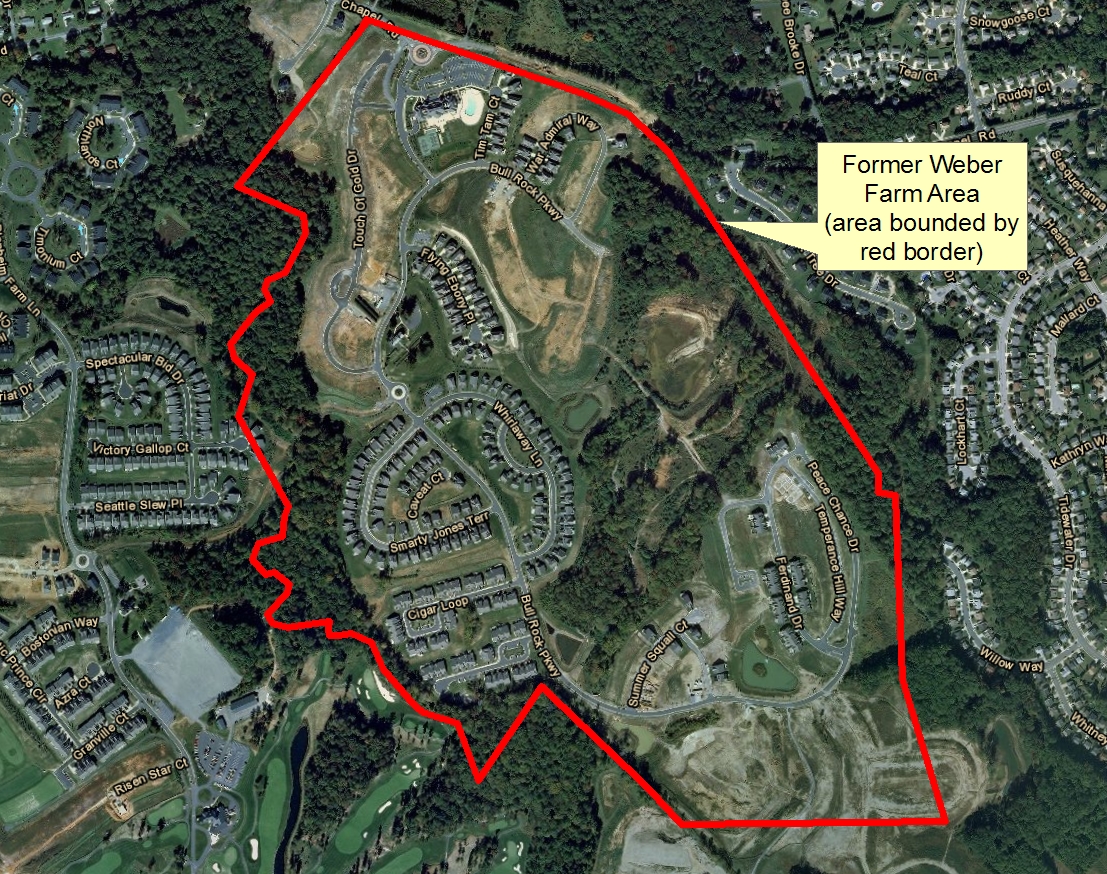The Former Weber Farm property is located within a portion of the Residences at Bulle Rock development in Havre de Grace, Harford County, Maryland. The property was once an orchard and has been redeveloped for residential use. Historic aerial photographs indicate that the orchards were in an area northeast of Gashey's Creek and the Blenheim Road properties, which encompasses roughly half of the Bulle Rock Parkway side of the golf course community project.
Site History
According to Phase I Environmental Site Assessments (ESAs), land records and historic aerial photographs document that the Former Weber Farm and surrounding areas were orchards, farms, and undeveloped woodlands dating back to the 1950s. A 1957 aerial photograph shows numerous residential dwellings and barn-sized outbuildings located on the property. A review of the 1967 aerial photograph showed the construction of a lake, but no significant changes to the property’s overall use.
The aerial photographs from the 1980s indicate that the majority of the orchards on the property were removed and portions of the former orchard had been converted to row crops in 1986. By 1995, only a small area of the property contained orchards, and most of the former orchard area had been converted to field crop production.
In the late 1990s, the Weber Farm, as part of a much larger development, was sold for the purpose of developing the entire property with two golf courses and residences. Substantial grading for the development of the golf courses occurred at the site, but work on the project was discontinued around 2000. The property was subsequently sold to a different development entity in 2004, and the new development plan for the entire area, including the Former Weber Farm, called for operating the existing golf course and subdividing parts of the remaining property for residential development and amenities. The remainder of the Residences at Bulle Rock development shows no evidence of having been used as an orchard.

Environmental Investigations
As early as 1995, a number of environmental site assessments, which included the collection and analysis of select soil samples, have been conducted on the property that became Bulle Rock. The prior environmental assessments were not submitted to MDE for review at the time they were conducted. More recent environmental investigations and testing have been conducted on specific portions of the Former Weber Farm property in areas where development was planned and where there were suspected environmental concerns. The environmental testing has focused on areas where the orchards were previously located.
The sampling indicates that soils in the orchard areas were impacted from historic applications of pesticides containing arsenic compounds, a practice which was common for decades at orchards and farms. During normal application, pesticide compounds containing arsenic would bind to the top few inches of soil beneath the trees. Based on the results of the soil samples submitted to MDE, the reported levels of arsenic in the surficial soil samples located at the property exceed the MDE residential screening level and the natural background levels for arsenic within this region of Maryland.
The developer of Bulle Rock informed MDE of the results from limited soil testing conducted in the summer of 2010 on a part of the undeveloped portion of the Former Weber Farm property. At that time, the developer also submitted copies of Phase I ESAs dated January 1999, March 2003, January 2007, and April 2010, summarizing specific areas of the Former Weber Farm property, were submitted to the MDE.
In March and April 2011, the MDE approved sampling plans submitted by the site developers detailing the collection of additional samples throughout the affected areas of the Former Weber Farm property in order to determine arsenic levels and the bioaccessibility of the arsenic. Since the initial disclosure, the developer has conducted additional sampling and conducted a bioaccessibility study to determine the fraction of arsenic that is soluble in the gastrointestinal system and is available for absorption. As a result of this study, MDE established a site-specific remedial goal for residential properties where arsenic is present in the soil at concentrations greater than 20 milligrams per kilogram (mg/kg). For common areas, MDE's site specific remedial goal is 38 mg/kg or greater.
Current Status
Throughout 2011 and 2012, several parties have conducted assessment and remediation activities throughout the former Weber Farm area. Many of the lots assessed by the parties were determined to require no further action as the levels of contaminants were below MDE's remedial goals. The properties that received MDE's "No Further Action" letter are listed in the table that is linked to this web page (Weber Farm NFAs Issued as of 02/23/2013). Additional sampling and remediation activities are still underway within boundaries of the former Weber Farm area.
What is the Contaminant of Concern?
Arsenic is a naturally occurring metalloid (metal-like) element. In nature, it is usually found in combination with other elements. The mineral (inorganic) forms of arsenic are generally more toxic than its more complex organic compounds which occur naturally in plant and animal tissues. Click here for additional information on the potential health impacts of arsenic or check the federal Agency for Toxic Substances and Disease Registry (ATSDR) at: www.atsdr.cdc.gov/tfacts2.pdf
Contact Information
For more information, please contact the Controlled Hazardous Substance Enforcement Division at 410-537-3493.